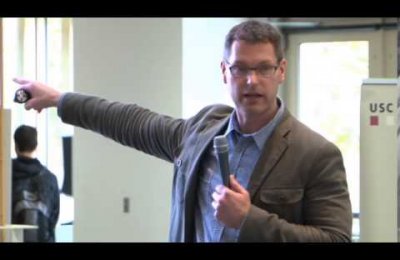By Laura Nelson
Student Writer
USC Annenberg welcomed nearly 300 high school journalism students and their advisers to USC on Nov. 5 for a day of lectures, discussions and classes on the art and practice of journalism.
The annual High School Journalism Day gives high school students the chance to learn more about written, visual and multimedia journalism from industry professionals and USC faculty.
Students rotated through three one-hour sessions on topics ranging from media ethics to film criticism, investigative journalism and a crash course in public relations. They also attended a keynote address from the LA Times journalists who published "Grading the Teachers," an analysis of the LAUSD's current method of teacher performance review.
During the media ethics class, Cal State Fullerton professor Tom Clanin walked a group of about 30 students through some of journalism's most infamous ethics scandals — Jayson Blair of The New York Times, Stephen Glass of The New Republic, Janet Cook of the Washington Post — and discussed why the publications involved chose to publish highly visible corrections.
Clanin then gave the students their own ethical dilemma to discuss: the high school quarterback has been caught sending inappropriate text messages to the head cheerleader. Both students are well-known on campus. Do you run the story? How? Why or why not?
Andy Rivera, a senior at Belmont High School, chose the ethics session because as editor-in-chief of the Belmont Sentinel, he copy edits all headlines, stories and photos before they're published.
"Ethics isn't the most exciting class but it's really important," Rivera said. "I need to make sure that everything's okay before we run it."
The other 9 a.m. sessions included a workshop on broadcast journalism, a discussion of public relations, a class on photojournalism and an advisers-only session on how to integrate print and web capabilities.
During the 10 a.m. session, Annenberg TV News opened its studio to the high school students. Executive producers and Annenberg students Kristen Steach and Marie Agnello and sports director Alex Wilk told the group about ATVN's daily 30-minute live news broadcast and showed the group a highlight reel of ATVN's biggest recent stories.
Then, students tried the technical studio positions in ATVN's Hancock Building studio during a five-minute newscast. Positions ranged from anchor to camera operator and teleprompter operator.
Patrick Garcia, a senior from Carson High School, went to the broadcast session in 2009 and liked it so much, he came back.
"I do print journalism at school, so I wanted to look at things from a different angle," Garcia said.
The other 10 a.m. classes included a crash course in 1st Amendment rights, a yearbook improvement session, a digital journalism workshop and a session on free tools for multimedia journalism.
During the 11 a.m. session, the LA Times reporters who broke the Bell pay scandal spoke to a group of about 150 students in the Annenberg Auditorium.
Over the summer, Jeff Gottleib and Ruben Vives exposed that Bell city council members earned as much as $100,000 for part-time work, rather than the $400-a-month stipend recommended for a city of its size. Since the first story, the Los Angeles County district attorney and the state attorney general have opened inquiries.
Gottleib and Vives talked the students through the investigative process, using the Bell stories as an example. They also addressed the importance of investigative journalism, even though feature and narrative writing might have wider appeal.
"We were every day slamming this stuff into the paper, and eventually, the whole story became narrative, became like a soap opera," Gottlieb said. "Every day, people would pick up the paper and say, 'OK, what's the story today? What's the new episode?' And that's exciting."

Reporters Jason Felch and Jason Song and Times database editor Doug Smith talked about the decision and process of reporting on value-added analysis. Rather than looking at each year's test score at face value, value-added analysis looks at changes in a student's test performance from year to year to evaluate the effectiveness of each teacher. The Times database rated and named almost 6,000 LAUSD teachers.
Song, Felch and Smith said during the year they worked on the project, they tried not to worry about the repercussions of naming individual teachers.
"We know Ms. X, in X school, is a highly ineffective teacher, and we know that 45 percent of students will perform worse when in her class," Felch said. "So what argument is there to not make that argument public? Ultimately, we decided it was unethical to withhold that information."
Song said they knew policy-making could be a result of the story, but that they tried not to think it. Journalists, he said, can only provide the information, not shape its repercussions.
"We don't know what the policy implications are going to be of what we've done," Song said. "We've tried to be honest and explain this information and get people talking. We can't control, nor is that our role to control, what goes on after we've shared that information."
Pasadena High School students Charles Crowley and Brennan Torres said they didn't start following the story until after a highly publicized suicide of an LAUSD teacher.
"We heard a lot about that teacher's death, and we were interested in hearing the journalists' side of the story," Crowley said.








